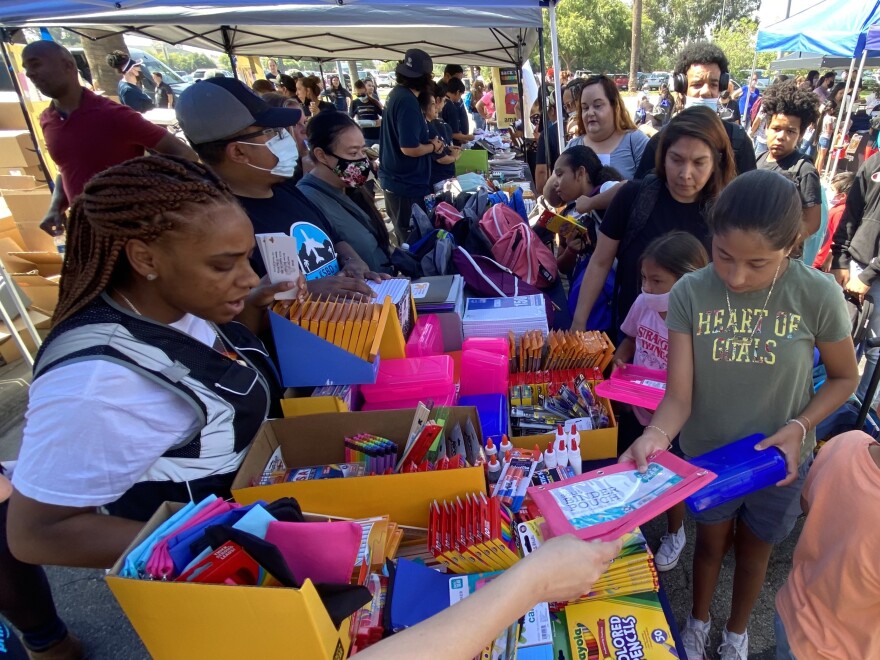Truth matters. Community matters. Your support makes both possible. LAist is one of the few places where news remains independent and free from political and corporate influence. Stand up for truth and for LAist. Make your year-end tax-deductible gift now.
After An Especially Long Lockdown, San Bernardino Schools Are Set To Reopen

When a new school year begins in San Bernardino on Monday, Earl Benjamin’s son will set foot inside a classroom for the first time since March 2020.
“I’m feeling great about it,” Benjamin said with a laugh, “because it’s time for him to get back out the house! Get off that PS4!”
His son, a high school senior, has been stuck at home with his video games longer than most Southern California students. The San Bernardino City Unified School District kept campuses closed through all of last school year — even in the spring, when all but a handful of school districts in the region resumed in-person classes.
Now — after a voluntary, in-person summer school program — San Bernardino school officials are planning for most of the district’s 53,000 students to return to campuses for “a full day of learning that resembles a regular school day pre-COVID-19.”
Benjamin’s glee is mixed with some trepidation. He supported the district’s decision to keep campuses closed. He’s worried about the recent spike in coronavirus cases. He said if it were up to him, San Bernardino campuses wouldn’t reopen until January.
On the other hand, Benjamin said his son slipped in his studies during the pandemic. Students like him “have been suffering for [16] months at home. Parents are out of jobs and out of work.”
“It’s time to get back to it,” he said. “Get the world back moving again.”
‘Their Kids Are Going To Be Well Taken Care Of’
The decision to keep school campuses closed last spring was as much about timing as about public health conditions: by the time officials said reopening was possible, only six weeks remained in the school year. (San Bernardino’s school year starts in early August and runs until the end of May.)
That said, San Bernardino City Unified — the region’s third-largest school district after Los Angeles and Long Beach — serves many demographic groups that have borne the brunt of the pandemic. Nearly 77% of the district’s students are Latino and 11% are Black.
In San Bernardino County, around one-third of all eligible Latinos are fully vaccinated, and around one-quarter of all eligible Black residents have gotten their shots. (Overall, around 48% of county residents are fully vaccinated.)
There’s some real concern there around what COVID could do to the rest of the family if they allow their child to go to school.
“Vaccination rates are not high in our community,” said Sandra Rodriguez, the school district’s assistant superintendent for student services. “Vaccinations for children are still not available. Many of our families live in multi-generational homes, where you have a grandmother or an elderly aunt living with them. There’s some real concern there around what COVID could do to the rest of the family if they allow their child to go to school.”
Rodriguez says the district’s biggest challenge is to help assuage parents’ fears about sending their kids back to campus: that students will wear masks indoors, that the district will maintain a more stringent cleaning regimen.
“We’re trying our best to get people to understand all about the precautions we’re taking,” Rodriguez said, “and, in addition, to let them know their kids are going to be well taken care of.”
“The best place for kids to learn is at their home school,” she said, “so we’re really pushing that.”
‘Just Have Faith’
San Bernardino City Unified is offering an online option. In addition to online courses, the district is also offering a more traditional independent study option, which involves weekly check-ins with teachers. But only about 1,000 students — out of more than 53,000 in the district — have opted out of a return to in-person instruction, Rodriguez said.
Rosa Loera, a volunteer and a member of the district’s English Learner Advisory Committee, has been calling fellow parents to convince them it will be all right to send their kids back to campus.
The most common fear among parents that Loera encounters is that younger students will hug each other too often — and otherwise get too close together.
Loera said she tries to reassure them: “We’re always telling them to put their masks on,” she tells the parents. “We’re telling them, ‘No, stay on your side. Put your mask on. Wash your hands. Don’t do that.’"
Loera’s oldest daughter recently graduated from high school. Her 14- and 16-year-old children still attend the district’s schools.
Loera recently talked to the mother of an only child, who seemed to really be struggling with sending her son back.
“She’s so protective with her son because it’s her only son,” Loera recounted. “She’s like, ‘I’m so afraid.’”
“Don’t be,” Loera told her. “Just have faith. Just have hope and everything’s going to be okay.”







